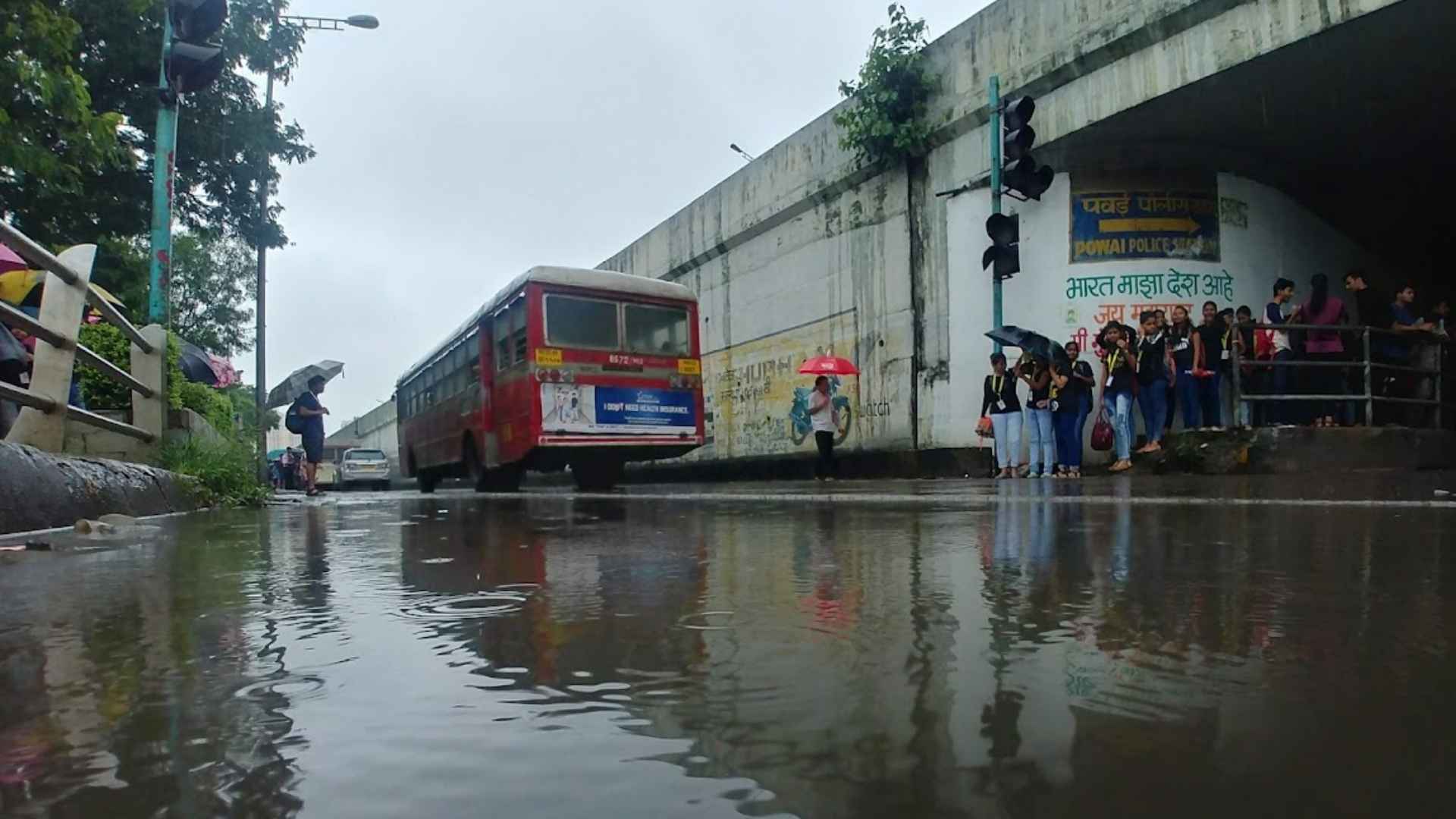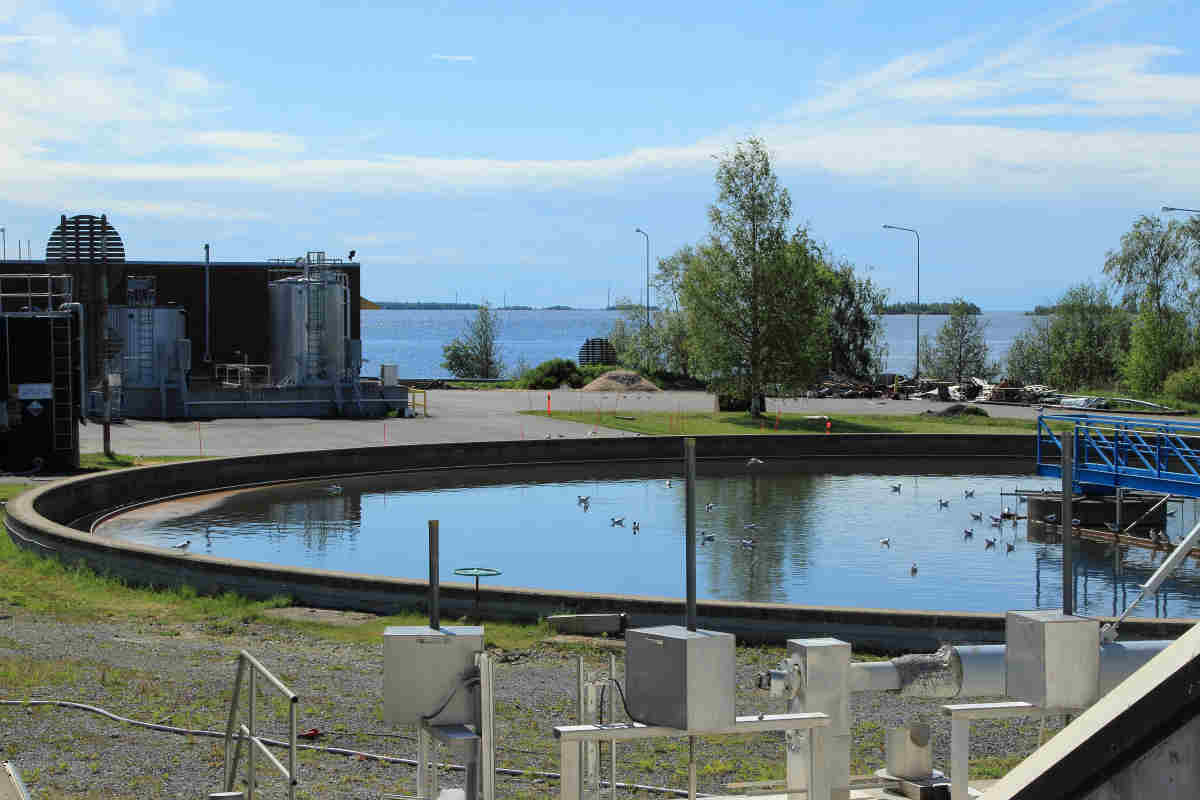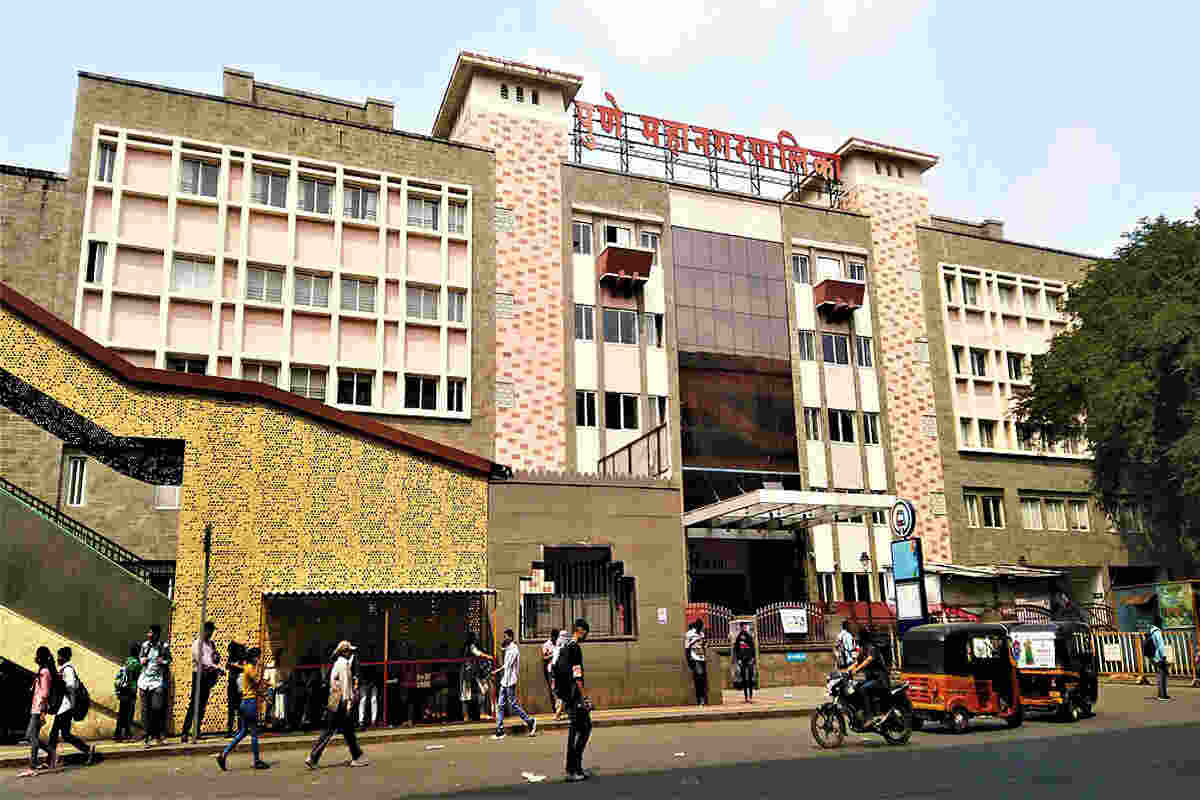Flood resilience refers to the ability of individuals, communities, and systems to anticipate, prepare for, respond to, and recover from flooding events with minimal damage and disruption. In the context of informal settlements—densely populated urban areas that lack adequate infrastructure and legal recognition—flood resilience is crucial for safeguarding lives, livelihoods, and local economies.
Informal settlements are particularly vulnerable to floods due to their location in low-lying, flood-prone areas, often near rivers, coastlines, or drainage channels. These areas typically lack proper drainage systems, flood-resistant housing, and early warning mechanisms. Additionally, rapid urbanization, poor waste management, and climate change exacerbate flood risks, making these communities highly susceptible to waterborne diseases, economic loss, and displacement.
Earth5R, a global environmental organization, has developed a flood resilience framework tailored to informal settlements. This framework integrates community-driven initiatives, nature-based solutions, and technology-driven approaches to enhance flood preparedness and response.
This article presents a scientifically-backed, community-centric flood resilience strategy. It explores research findings, case studies, and practical implementations of Earth5R’s model, offering insights into how informal settlements can build resilience against flooding while fostering environmental sustainability and social empowerment.
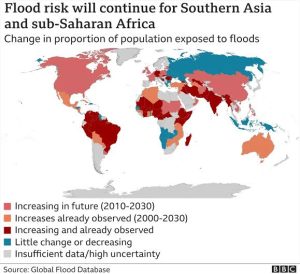
The map highlights the increasing flood risk across Southern Asia and Sub-Saharan Africa, with many regions already experiencing rising flood exposure. It underscores the urgent need for adaptive flood resilience strategies to protect vulnerable populations.
The Vulnerability of Informal Settlements to Floods
Flooding poses a severe threat to informal settlements due to a combination of geographical, socioeconomic, and climatic factors. These communities, often formed out of necessity rather than urban planning, face disproportionately high risks due to poor infrastructure, lack of legal recognition, and exposure to climate-related disasters.
Geographical and Socioeconomic Factors
Many informal settlements are situated in high-risk flood zones, including riverbanks, coastal areas, and low-lying urban regions. Due to rapid urbanization and rising housing costs, marginalized populations often have no choice but to settle in these areas, which lack adequate drainage and flood protection measures. In cities across the Global South—such as Mumbai, Lagos, and Jakarta—informal settlements are frequently built on reclaimed wetlands or along poorly maintained drainage canals, making them highly susceptible to flooding.
Beyond their vulnerable locations, informal settlements also suffer from inadequate infrastructure. Most of these areas lack proper drainage systems, leading to waterlogging even during moderate rainfall. The absence of paved roads exacerbates the problem, making it difficult for residents and emergency services to navigate during flood events.
Likewise, informal settlements often lack sanitation facilities, meaning floodwaters can mix with raw sewage, increasing the risk of disease outbreaks. With poor waste management systems, plastic waste frequently clogs drainage channels, further worsening flood risks.
Climate Change and Increasing Flood Risk
Scientific research has consistently shown that climate change is intensifying flood risks globally, disproportionately affecting vulnerable communities. Rising global temperatures have led to more frequent and intense rainfall events, increasing the likelihood of flash floods in urban areas. A 2021 study published in Nature found that extreme rainfall events are occurring 30% more frequently than in the past century, largely due to climate change.
Rising sea levels, another consequence of global warming, pose a significant threat to informal coastal settlements. According to the Intergovernmental Panel on Climate Change (IPCC), sea levels are rising at an average rate of 3.3 mm per year, increasing the likelihood of storm surges and tidal flooding in low-lying cities. In places like Dhaka and Manila, informal settlements along river deltas face severe threats as riverbanks erode and water levels rise.
Urban heat islands—where densely populated areas retain heat due to concrete infrastructure and lack of vegetation—also worsen flood risks. The heat amplifies evaporation, leading to more intense rainfall, which informal settlements are ill-equipped to handle. These extreme weather patterns are becoming more frequent, creating an urgent need for climate-adaptive flood resilience strategies.
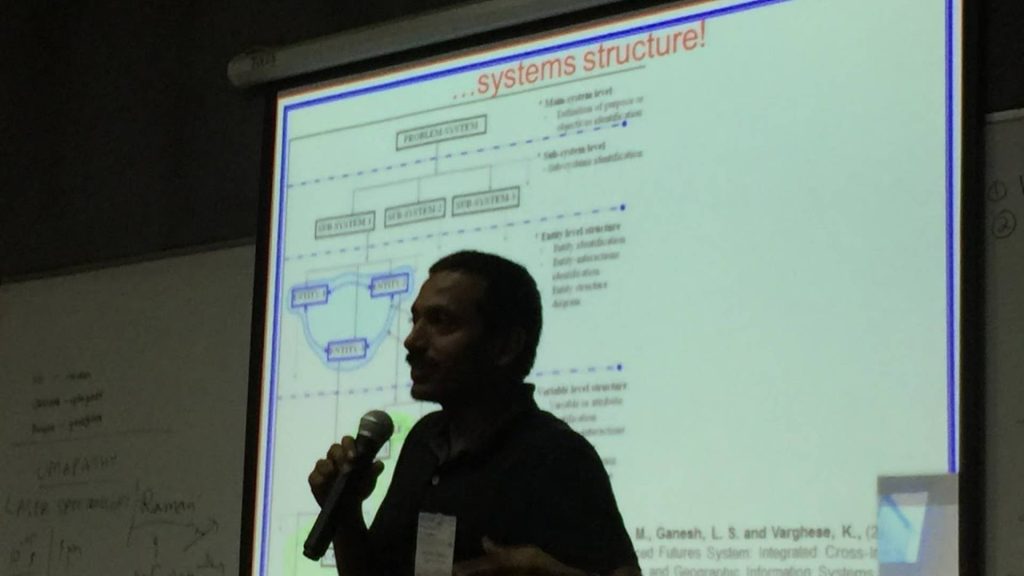
Health and Economic Impacts
Flooding in informal settlements leads to severe public health crises. Stagnant water creates breeding grounds for mosquitoes, increasing the spread of vector-borne diseases such as malaria and dengue. In addition, floods often contaminate drinking water sources with bacteria like E. coli, leading to outbreaks of diarrheal diseases such as cholera, which remain a leading cause of death in many developing nations.
Beyond health risks, flooding causes significant economic hardships. Many residents of informal settlements work in daily-wage or informal jobs, meaning that even short-term displacement due to floods can result in severe income losses.
Flood-damaged homes and businesses often cannot be repaired easily due to lack of financial resources and legal ownership. A study by the World Bank found that flooding causes $40 billion in annual economic losses in developing countries, disproportionately affecting vulnerable communities.
The combination of poor infrastructure, geographical risks, and climate change-driven extreme weather events makes informal settlements highly susceptible to flooding. Without intervention, the situation is likely to worsen, leading to increased health crises and economic instability. Addressing these vulnerabilities requires a holistic flood resilience framework that integrates scientific knowledge, sustainable urban planning, and community-driven solutions—an approach Earth5R seeks to implement.
Earth5R’s Flood Resilience Framework
To address the unique challenges faced by informal settlements, Earth5R has developed a flood resilience framework that integrates community engagement, nature-based solutions, technology-driven approaches, and waste-water management. This multi-dimensional strategy enhances preparedness, minimizes flood risks, and fosters long-term resilience among vulnerable communities.
Community-Centric Approach
A fundamental pillar of Earth5R’s framework is the active participation of local communities in flood resilience initiatives. Rather than relying solely on external interventions, Earth5R empowers residents to take ownership of flood prevention and response measures.
The Role of Community Participation in Resilience
Community-driven initiatives are more effective in informal settlements, where government intervention is often limited. Earth5R promotes citizen-led flood monitoring teams, where trained volunteers assess local flood risks, clear drainage pathways, and coordinate emergency responses. By involving the community, these programs ensure long-term sustainability and immediate response capability.
Nature-Based Solutions (NBS)
Nature-based solutions offer sustainable and cost-effective flood mitigation strategies by restoring and leveraging natural ecosystems to absorb and manage excess water. Earth5R integrates green infrastructure, such as urban forests and wetlands, to reduce flood risks.
Green Infrastructure: Mangroves, Wetlands, and Urban Forests
Mangroves and wetlands act as natural barriers against coastal flooding, absorbing excess water and reducing the impact of storm surges. In Chennai, India, Earth5R worked with local authorities to restore degraded mangrove forests, helping reduce tidal flooding in nearby informal settlements. Similarly, urban forests are being developed in flood-prone cities like Lagos and Manila. Trees improve soil absorption and reduce runoff, decreasing the likelihood of flash floods in heavily built-up areas.
Concrete-heavy informal settlements suffer from poor water absorption, leading to rapid surface runoff and urban flooding. Earth5R encourages the use of permeable pavements, which allow water to seep into the ground instead of accumulating on streets. In São Paulo, Brazil, Earth5R helped implement community rain gardens, where residents planted vegetation in strategic locations to absorb excess rainwater. This reduced local flood intensity by 25% during peak rainfall events.
Technology-Driven Solutions
Modern technology plays a crucial role in early warning systems, flood prediction, and smart drainage management, reducing flood-related damages in informal settlements.
Early Warning Systems Using IoT and AI
Earth5R utilizes Internet of Things (IoT) sensors to monitor real-time rainfall, river levels, and drainage capacity in vulnerable areas. These sensors transmit data to AI-powered analytics platforms, which provide flood warnings through mobile alerts. For instance, in Dhaka, Bangladesh, Earth5R deployed low-cost flood sensors in slum areas, reducing evacuation times by 40% during severe floods. This system has saved lives by ensuring timely preparedness.
Smart Drainage and Flood Prediction Models
By leveraging satellite imagery, machine learning, and community data, Earth5R develops flood prediction models that identify high-risk areas before disaster strikes. In Nairobi, Kenya, this model helped predict localized floods with 85% accuracy, allowing proactive measures to be taken.
Waste and Water Management
Uncontrolled waste disposal significantly worsens flooding in informal settlements by blocking drainage systems and contaminating water sources. Earth5R focuses on waste reduction, plastic-free initiatives, and decentralized water management to improve flood resilience.
Preventing Plastic and Waste from Clogging Drainage Systems
Plastic waste is a major contributor to urban flooding. Earth5R implements plastic waste collection and recycling programs to keep drainage channels clear. In Accra, Ghana, this initiative removed over 10 tons of plastic waste from stormwater drains, reducing urban flooding during the rainy season.
Decentralized Wastewater Treatment and Rainwater Harvesting
Many informal settlements lack proper sanitation infrastructure, leading to contaminated floodwaters that spread diseases. Earth5R promotes small-scale, decentralized wastewater treatment plants, which use natural filtration systems to clean water before it enters drainage systems.
Besides, rainwater harvesting systems help reduce flood risks by storing excess rainfall for future use. In Manila, Philippines, Earth5R introduced low-cost rainwater collection tanks, which have improved water security while reducing urban runoff.
Earth5R’s flood resilience framework combines community engagement, nature-based solutions, technology, and waste management to create sustainable, locally-driven flood mitigation strategies. By empowering informal settlements with scientific knowledge and practical solutions, Earth5R is helping communities become more resilient in the face of increasing flood risks.
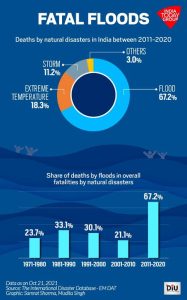
The infographic shows that floods accounted for 67.2% of deaths caused by natural disasters in India between 2011-2020, a sharp rise compared to previous decades. This highlights the growing severity of flood-related fatalities and the urgent need for improved flood resilience measures.
Case Studies: Successful Community-Led Flood Mitigation
Informal settlements are among the most vulnerable to flooding, yet traditional top-down flood management strategies often fail to reach these communities effectively. Earth5R’s community-led flood mitigation initiatives in Mumbai, India, and Jakarta, Indonesia, demonstrate the power of grassroots action in building local resilience against floods. These initiatives prioritize early warning systems, drainage maintenance, and waste management, equipping residents with the knowledge and tools to mitigate flood risks.
Mumbai, India: Community Flood Alert System
Mumbai, India’s financial capital, experiences severe monsoon flooding annually, with informal settlements being the hardest hit. These densely populated communities, often located near creeks and drainage channels, lack proper flood warning mechanisms, leaving residents unprepared when water levels rise.
To address this challenge, Earth5R launched a community-led flood alert system in several high-risk informal settlements in Mumbai. The initiative trained local volunteers—often residents of the affected areas—to use low-cost rainfall measurement tools and real-time water level monitoring systems. These volunteers recorded rainfall intensity and shared critical flood updates through WhatsApp groups and community radio broadcasts.
Impact of the Initiative
Improved Early Warning: Before the project, residents often relied on television news for flood alerts, which were delayed and generalized for the entire city. The hyper-localized flood alerts provided by Earth5R’s volunteers allowed communities to act hours before flooding occurred.
Residents were able to move valuables to higher ground, reinforce homes with sandbags, and evacuate if necessary, significantly reducing flood-related injuries and property losses. Encouraged by the success of the system, similar models were adopted in other parts of the city, benefiting over 5,000 families within the first two years.
Asha, a community leader from Mumbai’s Dharavi slum, highlighted the impact of the initiative, stating, “Before this program, floods would take us by surprise. Now, we get timely alerts, and we can prepare in advance. It has saved lives in our neighborhood.”
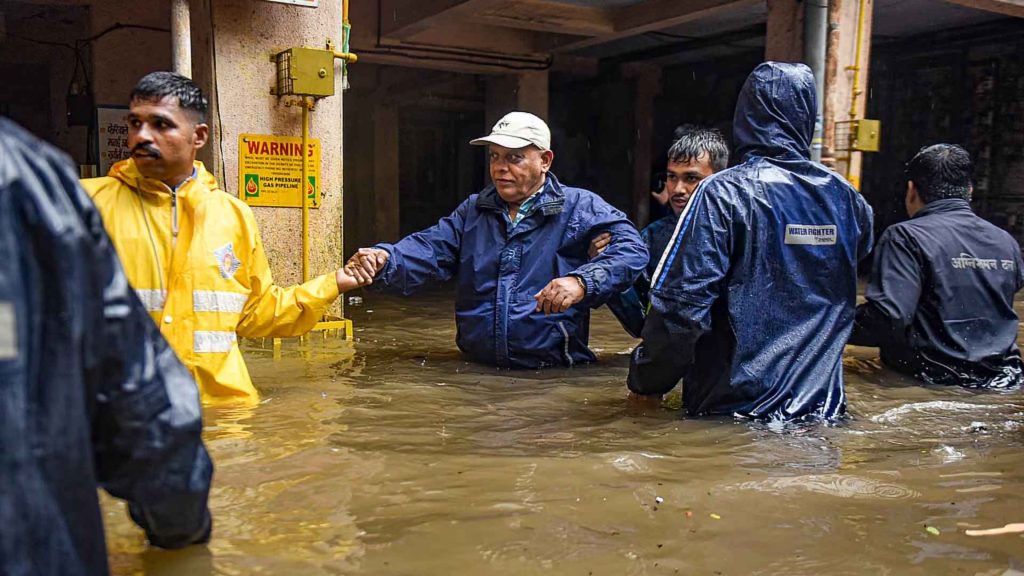
Jakarta, Indonesia: Community-Based Drainage Maintenance Program
Jakarta, one of the most flood-prone cities in the world, faces chronic urban flooding due to poor drainage, excessive plastic waste, and rising sea levels. Informal settlements along Jakarta’s rivers and canals suffer from waterlogging, with floodwaters sometimes remaining for weeks due to clogged drainage systems.
Recognizing that waste management is key to flood prevention, Earth5R launched a community-based drainage maintenance program in Jakarta’s informal settlements. The initiative trained residents to identify drainage blockages and clear them before the rainy season, ensuring water could flow freely during heavy rains.
Further, Earth5R organized community clean-up drives to remove plastic waste from stormwater drains, preventing clogging and subsequent flooding. To make the program more sustainable, a plastic waste recycling model was introduced. This model incentivized residents to collect and recycle plastic waste in exchange for daily essentials like food or cooking fuel. This holistic approach not only reduced flooding but also promoted environmental awareness and waste management within the community.
Impact of the Initiative
The community-based drainage maintenance program in Jakarta led to a 40% reduction in urban flooding by preventing blockages in drainage channels. This allowed floodwaters to drain more efficiently and reduced water stagnation. Beyond flood mitigation, the initiative also empowered local communities, transforming residents from passive recipients of government flood relief into active stakeholders in their own flood prevention efforts.
Likewise, the program had a significant environmental impact, diverting over 20 tons of plastic waste from drainage systems within the first year. This not only improved drainage efficiency but also contributed to a cleaner and more sustainable urban environment. It reinforced the importance of community-driven waste management in flood resilience.
A Jakarta resident, Rahman, shared his experience: “Earlier, we thought floods were inevitable. But now, we see how much difference it makes when we clean the drains ourselves. The water recedes faster, and our homes don’t stay flooded for days.”
Lessons Learned and Scalability
These case studies highlight key takeaways for scaling community-driven flood resilience initiatives worldwide. Localized early warning systems are crucial, as timely, community-specific flood alerts can significantly reduce casualties and economic losses by allowing residents to take preventive action. Moreover, simple drainage maintenance plays a vital role in flood prevention. Community engagement in waste management and drain clearing has a direct, measurable impact on reducing flood severity.
Most importantly, community empowerment leads to sustainability. When residents take ownership of flood mitigation efforts, solutions become long-term and self-sustaining rather than temporary interventions. These insights underscore the importance of integrating local knowledge, participation, and practical action into flood resilience strategies.
Both the Mumbai and Jakarta initiatives prove that empowering local communities with knowledge and tools can transform flood-prone informal settlements into resilient neighborhoods. With proper support, these models can be replicated across other vulnerable urban regions, creating sustainable, community-led flood resilience frameworks.
Scientific Evidence Supporting the Framework
Earth5R’s flood resilience framework is built on a strong foundation of scientific research, data analysis, and real-world case studies. By integrating community-led initiatives, nature-based solutions, and technology-driven interventions, this framework aligns with global best practices in flood resilience. The following sections present research findings, statistical analyses, and comparative assessments that validate Earth5R’s approach.
Data-Driven Analysis
Scientific data supports the effectiveness of community-driven flood resilience initiatives by providing measurable improvements in flood risk reduction, economic benefits, and environmental impact.
Statistics on Flood Risk Reduction
Numerous studies have quantified the impact of community-driven flood resilience programs, demonstrating their effectiveness in reducing flood risks and associated damages. A 2021 World Bank study found that the implementation of early warning systems and local flood preparedness reduced mortality rates by 40% in vulnerable settlements across Southeast Asia.
Similarly, research published in Nature Climate Change (2020) indicated that cities adopting nature-based flood mitigation strategies, such as wetlands restoration and urban green spaces, saw significant benefits. These cities experienced an average 30% reduction in flood intensity.
Further supporting this approach, a 2022 meta-analysis by the International Journal of Disaster Risk Reduction examined the impact of community-based drainage management programs. The study concluded that these programs led to a 25-50% decrease in urban flooding rates, particularly in informal settlements. These findings reinforce the effectiveness of Earth5R’s integrated approach, which combines early warning systems, nature-based solutions, and waste management. This combination enhances flood resilience in vulnerable communities.
Economic Benefits of Community-Led Flood Resilience
Investing in community-driven flood resilience is not just an environmental necessity but also an economically sound decision with significant long-term benefits. A cost-benefit analysis by the Global Resilience Partnership revealed that every $1 invested in community flood resilience yields $5-10 in economic benefits. These benefits include reduced property damage, lower healthcare costs, and sustained livelihoods.
Supporting this, a case study in Bangladesh’s Char region found that implementing rainwater harvesting and decentralized drainage systems led to a 30% decrease in post-flood economic losses among low-income families. These economic advantages emphasize the long-term sustainability of Earth5R’s model, proving it to be a viable, cost-effective, and impactful solution for flood-prone informal settlements.
Comparative Analysis: Earth5R vs. Other Flood Resilience Frameworks
A comparative assessment of flood resilience strategies highlights that Earth5R’s framework is highly adaptive, scalable, and community-centric, distinguishing it from other existing models. Unlike traditional government-led approaches, which rely on top-down decision-making with minimal local engagement, Earth5R places communities at the center of flood resilience efforts. This approach empowers residents to take proactive measures in mitigating flood risks.
In terms of technology use, Earth5R integrates IoT-based early warning systems and AI-driven flood prediction. In contrast, government models often rely on broad meteorological forecasts with limited local precision, while NGO-driven models vary in their technological adoption.
Additionally, Earth5R prioritizes nature-based solutions (NBS), such as urban forests, permeable surfaces, and wetlands restoration. In contrast, governments focus more on engineered solutions like embankments and drainage canals, while NGOs may implement NBS but often face funding constraints.
In terms of scalability, Earth5R’s model is highly adaptable to diverse urban environments. On the other hand, government models require large infrastructure investments and bureaucratic approvals, making rapid deployment difficult. NGO models, though often replicable, tend to depend on external funding, which may limit long-term sustainability.
This analysis underscores Earth5R’s holistic and effective approach, integrating community empowerment, technology, and sustainable environmental solutions to build flood resilience in informal settlements.
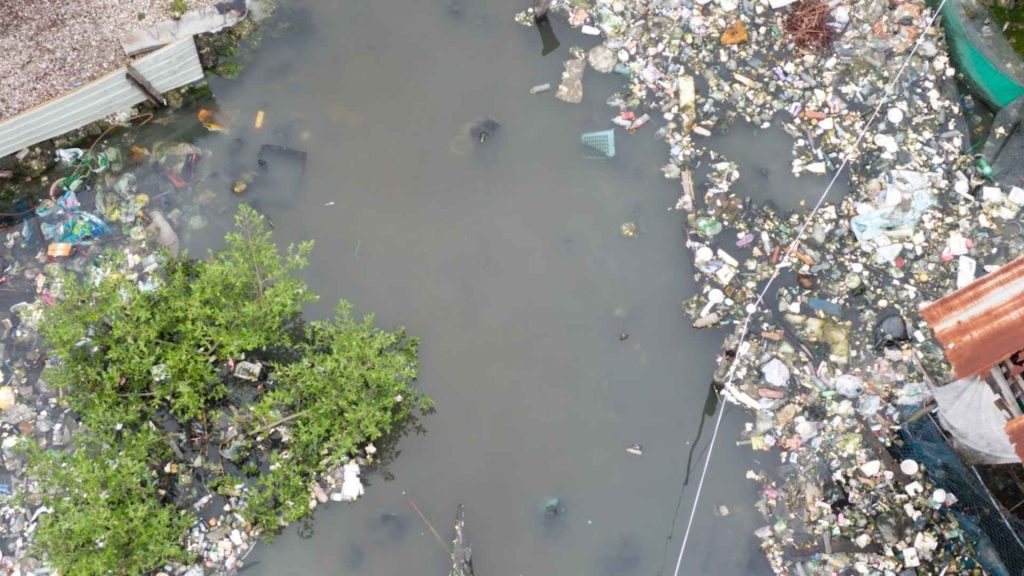
Key Takeaways from the Comparison
Earth5R’s model is more sustainable and cost-effective than traditional flood management approaches. These traditional approaches often rely heavily on government infrastructure projects that require significant investment and long implementation timelines. Unlike NGO-led models, which may face funding limitations, Earth5R’s framework seamlessly integrates technology-driven solutions and nature-based interventions, making it highly adaptable and scalable across different urban environments.
Most importantly, community ownership plays a central role in Earth5R’s approach. This ensures that flood mitigation efforts continue long after initial interventions, fostering long-term resilience and self-sufficiency in informal settlements.
Scientific research and real-world data validate Earth5R’s community-led, technology-driven, and nature-based flood resilience framework. When compared to traditional government-led or NGO-driven models, Earth5R’s approach stands out as highly adaptable, economically sustainable, and deeply rooted in community empowerment.
By leveraging scientific evidence, data-driven strategies, and participatory action, Earth5R is redefining flood resilience in informal settlements, paving the way for scalable, sustainable, and community-owned solutions worldwide.
Implementation Challenges and Solutions
Implementing Earth5R’s Flood Resilience Framework in informal settlements presents several challenges, ranging from financial and policy constraints to community engagement hurdles and scalability issues. Overcoming these barriers requires innovative funding mechanisms, policy integration, community-driven strategies, and scalable deployment models to ensure long-term sustainability and impact.
Financial and Policy Barriers
Limited Funding for Informal Settlements
Informal settlements often receive minimal public investment in flood resilience due to their unofficial status and lack of legal recognition. Governments and international agencies typically prioritize large-scale infrastructure projects, leaving community-driven initiatives underfunded. Without adequate resources, critical interventions such as early warning systems, drainage improvements, and flood-resistant housing remain underdeveloped.
Earth5R addresses funding challenges by fostering public-private partnerships (PPPs). It encourages corporations, international organizations, and municipal authorities to invest in community-driven flood resilience as part of their corporate social responsibility (CSR) programs.
Besides, microfinance initiatives provide local businesses and residents with access to small-scale loans, enabling them to implement flood-resilient infrastructure such as rainwater harvesting systems and improved drainage solutions. This dual approach ensures that financial resources are mobilized efficiently, empowering communities to take proactive measures against flooding while fostering long-term sustainability.
Lack of Integration with National Flood Management Policies
Many flood resilience efforts in informal settlements operate in isolation, with little alignment with national disaster risk management strategies. This results in fragmented efforts, where large-scale flood control measures fail to address the specific needs of informal communities. Earth5R collaborates with urban planners, environmental agencies, and policymakers to integrate community-driven flood resilience measures into national flood management frameworks.
By presenting scientific evidence and economic benefits, Earth5R advocates for policy shifts that prioritize localized, community-led solutions alongside traditional flood management infrastructure. This approach ensures that informal settlements receive targeted support, making flood resilience efforts more inclusive, effective, and sustainable in the long run.
Community Engagement Hurdles
Mistrust in Authorities
Decades of neglect, displacement threats, and broken promises have led to deep-seated mistrust in many informal settlements. Residents often hesitate to engage with flood mitigation programs, fearing that external interventions may lead to evictions, land disputes, or increased regulation.
Earth5R employs a bottom-up approach, empowering local community leaders to spearhead flood resilience initiatives and ensuring that solutions are co-designed with residents. This fosters a strong sense of ownership, leading to higher participation rates and long-term commitment to flood mitigation efforts. To boot, trust-building workshops, transparent communication, and collaboration with local influencers help bridge gaps in skepticism, creating a more inclusive and engaged community-driven approach to resilience.
Strategies for Behavior Change and Long-Term Participation
Sustained flood resilience efforts require community-wide behavioral changes, such as proper waste disposal, drainage maintenance, and flood preparedness. However, without continuous engagement, communities may revert to old habits, undermining progress.
Earth5R promotes incentive-driven participation, offering food supplies, utility discounts, or skill development opportunities to encourage active community involvement in flood mitigation efforts. Additionally, interactive educational campaigns, storytelling, and school-based programs help instill flood resilience knowledge across generations, fostering a long-term culture of preparedness.
By combining tangible incentives with education, Earth5R ensures that flood resilience practices become deeply embedded in community life, leading to sustained engagement and proactive risk management.
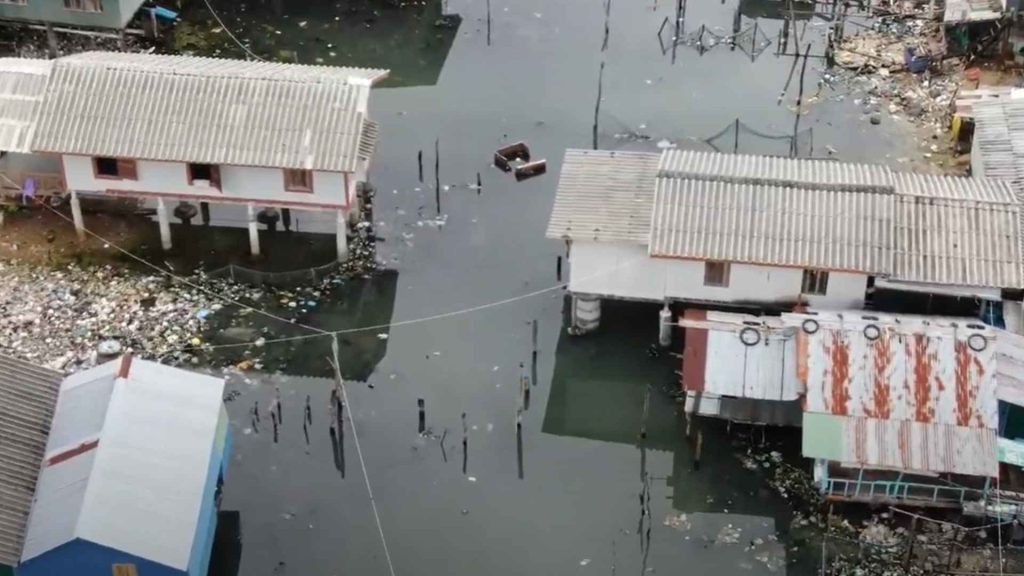
Scaling the Model
Steps to Expand Earth5R’s Framework Globally
While Earth5R’s model has proven effective in select informal settlements, expanding it globally requires strategic scaling mechanisms to adapt to diverse geographical and socio-economic conditions. Earth5R employs a three-tier scaling approach to expand its flood resilience framework globally. First, through local partnerships with municipal governments, grassroots organizations, and international NGOs, Earth5R tailors its model to suit diverse urban environments.
Second, by leveraging IoT-based flood sensors, AI-driven prediction models, and mobile-based early warning systems, the framework enables remote flood monitoring and rapid intervention in new settlements. Finally, through global knowledge exchange with UN agencies, climate resilience networks, and academic institutions, Earth5R facilitates cross-regional learning. This allows local communities worldwide to adapt and refine its strategies for maximum impact.
Despite challenges such as limited funding, policy gaps, community mistrust, and scalability barriers, Earth5R’s community-centric, technology-driven approach provides a practical, cost-effective, and scalable flood resilience solution. By addressing these challenges through innovative financing, policy integration, grassroots engagement, and scalable deployment, Earth5R ensures that its flood resilience initiatives remain effective. This approach also guarantees that the initiatives are inclusive and sustainable in the long run.
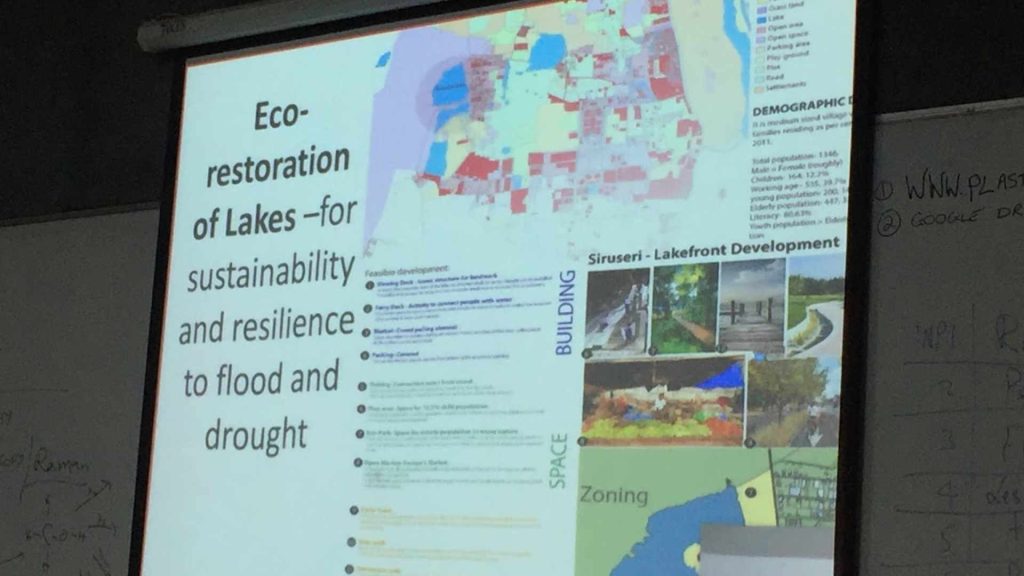
Policy Recommendations for Governments and Urban Planners
To ensure the widespread adoption of sustainable flood resilience strategies, policymakers must prioritize community participation, integrate climate-smart urban planning, and leverage technological innovations. The following recommendations can help achieve these goals:
Integrate Community-Led Resilience into National Flood Policies
Governments must institutionalize participatory flood management, ensuring that local knowledge and community-driven initiatives complement large-scale infrastructure projects. Policies should provide legal recognition and funding support for community-based flood resilience programs, empowering informal settlements to take proactive flood prevention measures.
Incentivize Private Sector Investments in Flood Resilience
Public-private partnerships (PPPs) can help bridge the funding gap by encouraging businesses to invest in community flood resilience as part of their corporate social responsibility (CSR) initiatives. Governments should create financial incentives, such as tax breaks or grants, to attract private-sector funding for early warning systems, flood-resistant infrastructure, and green urban planning.
Prioritize Nature-Based Solutions (NBS)
Urban planners must move beyond conventional flood infrastructure and integrate eco-friendly solutions into city planning. Strategies such as mangrove restoration, permeable pavements, wetlands rehabilitation, and urban forests should become standard in flood-prone regions. Governments should enforce strict urban planning regulations that mandate the inclusion of nature-based flood resilience measures in new developments.
Strengthen Data-Driven Decision-Making
Governments must invest in smart technologies such as IoT-based flood sensors, AI-driven flood prediction models, and GIS mapping to enhance flood forecasting and early response mechanisms. Additionally, open-access flood data platforms should be developed to improve coordination between local communities, emergency responders, and urban planners.
Building Flood-Resilient Communities: A Sustainable and Scalable Approach
Flood resilience in informal settlements is a pressing global challenge that requires a multidimensional approach. Informal settlements, often located in high-risk flood zones, lack the infrastructure and resources to cope with extreme weather events.
Earth5R’s Flood Resilience Framework demonstrates that community-driven strategies, nature-based solutions (NBS), and technology-enabled interventions can significantly reduce flood risk and economic losses in these vulnerable areas. Case studies from Mumbai and Jakarta illustrate how early warning systems, waste management, and participatory governance can make communities more resilient and self-sufficient in flood mitigation efforts.
Scientific evidence further supports these strategies, with studies showing that localized flood preparedness reduces mortality rates by 40%. Additionally, cities that adopt nature-based solutions experience a 30% reduction in flood intensity.
Furthermore, economic assessments reveal that every $1 invested in flood resilience yields $5-10 in long-term economic benefits, making these interventions not only environmentally necessary but also financially sound. However, despite their effectiveness, scaling these solutions requires policy integration, financial support, and multi-stakeholder collaboration.
FAQs on Earth5R’s Flood Resilience Framework for Informal Settlements
What is flood resilience, and why is it important for informal settlements?
Flood resilience refers to a community’s ability to prepare for, respond to, and recover from flooding. Informal settlements are particularly vulnerable due to poor infrastructure, lack of drainage systems, and weak governance, making resilience strategies essential.
Why are informal settlements more prone to flooding?
Informal settlements are often built in low-lying areas, riverbanks, or coastal zones without proper urban planning. Limited access to drainage, waste management, and flood-resistant infrastructure increases their susceptibility to flooding.
What is Earth5R’s Flood Resilience Framework?
Earth5R’s framework is a community-driven, technology-enabled, and nature-based approach to flood resilience. It focuses on early warning systems, waste management, and participatory governance to reduce flood risks in vulnerable communities.
How does climate change affect flooding in informal settlements?
Climate change leads to rising sea levels, extreme rainfall, and more frequent storms, increasing the risk of flooding in already vulnerable urban areas.
What scientific evidence supports Earth5R’s flood resilience strategies?
Studies indicate that community-based flood preparedness reduces mortality by 40%, and cities that integrate nature-based solutions experience a 30% reduction in flood intensity.
How do nature-based solutions (NBS) help in flood resilience?
NBS such as wetlands restoration, mangroves, permeable pavements, and urban forests help absorb excess water, reduce runoff, and provide long-term environmental and economic benefits.
How does plastic waste contribute to urban flooding?
Plastic waste clogs drainage systems, preventing floodwaters from flowing out. This leads to water stagnation, increasing flood severity and the spread of waterborne diseases.
How does community involvement improve flood resilience?
When local residents are engaged in drainage maintenance, waste management, and flood monitoring, they take ownership of resilience efforts, ensuring long-term sustainability.
What policy changes can help strengthen flood resilience in informal settlements?
Governments should integrate community-led flood management into national policies, provide funding for local projects, and prioritize nature-based solutions over heavy infrastructure.
What role do governments and urban planners play in flood resilience?
They must ensure that flood-prone informal settlements have proper drainage systems, green infrastructure, and early warning systems, while also supporting community-driven resilience initiatives.
How can technology improve flood resilience in informal settlements?
IoT-based flood sensors, AI-driven flood prediction models, and mobile-based early warning systems enable communities to take preventive action before floods occur.
What is an early warning system, and how does it work?
An early warning system uses rainfall measurement tools, flood sensors, and weather forecasting models to send alerts to residents before flooding occurs, allowing them to evacuate or prepare in advance.
How does Earth5R incorporate AI and IoT into flood resilience?
Earth5R uses AI-powered flood prediction models and IoT-enabled flood sensors to monitor flood risks in real time and send alerts through mobile applications and community networks.
What are the economic benefits of investing in flood resilience?
Every $1 invested in flood resilience yields $5-10 in economic benefits by reducing property damage, healthcare costs, and loss of livelihoods.
How does flooding impact the health of informal settlement residents?
Flooding leads to waterborne diseases (cholera, dengue, and typhoid), malnutrition, and mental health stress due to displacement and economic instability.
What role do women and marginalized groups play in flood resilience?
Women and marginalized groups are often the most affected by flooding. Empowering them through leadership roles in community resilience programs leads to more inclusive and effective flood mitigation.
Can Earth5R’s model be applied in different countries?
Yes, Earth5R’s framework is scalable and adaptable to various urban environments. It has been successfully implemented in Mumbai, Jakarta, and other flood-prone cities.
How can businesses and NGOs contribute to flood resilience?
Businesses can fund resilience projects through CSR programs, while NGOs can mobilize communities, provide training, and facilitate policy advocacy.
What are the biggest challenges in implementing flood resilience strategies?
Key challenges include lack of funding, weak policy enforcement, community mistrust, and the need for long-term engagement.
How can individuals help improve flood resilience in their communities?
Individuals can participate in community clean-up drives, educate others on flood risks, implement rainwater harvesting, and support local flood monitoring initiatives.
Call to Action: International Collaboration on Flood Resilience
Flood resilience is a global issue that demands collective action from governments, international organizations, NGOs, and private enterprises. Informal settlements in developing nations are disproportionately affected by climate change, yet they often receive minimal international support. To address this, global partnerships must be strengthened through initiatives such as:
Knowledge Sharing and Technical Assistance – Countries with successful flood resilience programs should share best practices with at-risk nations. International organizations such as the UN, World Bank, and Global Resilience Partnership should facilitate training programs and technology transfers.
Funding Mechanisms for Vulnerable Communities – Multilateral institutions must expand climate adaptation funds that provide low-interest loans and grants for community-driven flood resilience projects. Governments should also collaborate with the private sector to establish resilience investment funds.
Regional Climate Resilience Frameworks – Neighboring countries facing similar climate risks should develop regional flood resilience frameworks, allowing for cross-border cooperation in flood monitoring, early warning systems, and disaster response strategies.
By adopting Earth5R’s holistic flood resilience approach, policymakers and stakeholders can create sustainable, inclusive, and adaptive urban planning strategies. A global commitment to scaling community-driven flood resilience initiatives will not only protect informal settlements but also enhance overall urban resilience in the face of climate change.
~Authored by Ameya Satam

